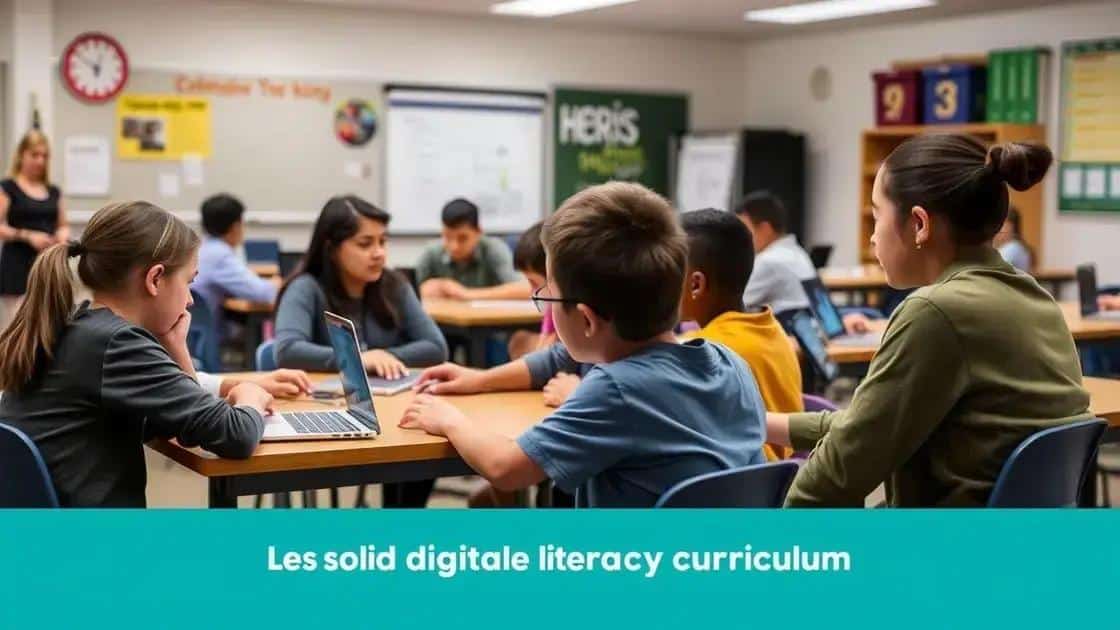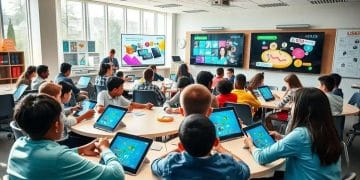Insights on digital literacy curriculum for effective learning

Evaluating and improving digital literacy programs involves gathering student feedback, analyzing learning outcomes, and incorporating community engagement, ensuring that educational initiatives meet learners’ needs effectively.
Insights on digital literacy curriculum are crucial for enhancing educational achievements today. Have you ever wondered how digital skills impact student engagement and employability? Let’s explore how a well-structured curriculum can make a difference.
Understanding the digital literacy framework
Understanding the digital literacy framework is essential for educators and students alike. It sets the stage for integrating technology into learning and helps create confident digital citizens.
The framework encompasses various skills and competencies that enable individuals to navigate the digital world effectively. As technology evolves, so do the necessary skills. This dynamic nature of digital literacy emphasizes the need for continuous learning and adaptation.
Core Components of Digital Literacy
To successfully develop a digital literacy curriculum, it’s important to focus on several core components:
- Technical skills: These are basic skills needed to use digital tools and platforms effectively.
- Information literacy: This involves the ability to find, evaluate, and utilize information responsibly.
- Media literacy: Understanding how media influences society and the importance of analyzing media critically.
- Communication skills: The ability to communicate effectively in digital spaces, which includes understanding online etiquette.
As you can see, these components work together to build a solid foundation for digital literacy. The goal is not just to teach students how to use technology, but to empower them to be responsible, critically thinking individuals in our digital age.
It’s also essential to recognize how digital literacy transcends traditional education. Today, it prepares students for the workforce, where such skills are increasingly demanded. By fostering a culture that values digital literacy, we help ensure that learners are well-equipped for future challenges.
Creating an Effective Curriculum
Building an effective digital literacy curriculum requires thoughtful design. First, educators should aim to make learning interactive. Incorporating projects and collaborative work can greatly enhance the learning experience. Consider engaging learners through:
- Interactive workshops that focus on hands-on technology use
- Group projects that involve research and digital presentations
- Simulations that offer real-world scenarios, allowing students to apply their skills
Furthermore, assessment methods should evolve alongside the curriculum. Traditional tests might not fully capture a student’s digital competencies; therefore, alternative methods like portfolios or presentations should also be included.
In summary, understanding the digital literacy framework is crucial for shaping a generation that can thrive in the digital environment. As educators, it’s our responsibility to equip students with the necessary skills and mindset to embrace the challenges and opportunities of the digital world.
Key benefits of a solid digital literacy curriculum

Understanding the key benefits of a solid digital literacy curriculum is vital for educators and students. A strong curriculum not only provides essential skills but also prepares learners for future challenges.
One major benefit is enhanced critical thinking. Students equipped with digital literacy can analyze information better, which helps them make informed decisions. As technology evolves, being able to evaluate multiple sources of information becomes crucial.
Improved Communication Skills
A digital literacy curriculum fosters improved communication skills. Students learn to express their ideas clearly in online settings and collaborate with peers. Knowing how to communicate effectively across various platforms is a skill that is increasingly valued in many fields.
- Engaging in group projects that require teamwork
- Using digital platforms to share insights and ideas
- Practicing online etiquette and respectful communication
The integration of digital tools makes learning more interactive. For instance, students can use forums and blogs to discuss topics, enhancing their engagement and understanding of the material.
Another significant benefit is increased confidence in technology use. A solid curriculum allows students to explore various digital tools, helping them feel more comfortable and capable in today’s tech-driven world. This comfort leads to a positive attitude towards learning and challenges.
Preparation for Future Employment
In addition, a comprehensive digital literacy curriculum prepares students for the workforce. Many jobs require a good understanding of technology. By integrating relevant skills into learning, educators help students develop competencies that are desirable to employers.
- Understanding how to use professional tools and software
- Learning how to perform digital research efficiently
- Gaining experience with online collaboration tools
This preparation not only makes students more competitive but also opens up opportunities in various fields. A robust curriculum recognizes the importance of skills beyond traditional subjects.
Overall, the benefits of implementing a solid digital literacy curriculum are expansive. From enhancing critical thinking to promoting communication skills, the advantages are clear. Students emerge more prepared for today’s world and future job markets, equipped with the skills needed to thrive in both academic and professional environments.
Best practices for teaching digital skills
When it comes to teaching digital skills, employing best practices can significantly enhance the learning experience for students. These practices ensure that the curriculum is effective, engaging, and relevant to today’s technology-driven world.
One important method is to integrate hands-on learning. Allowing students to experiment with technology can deepen their understanding. This approach makes learning active and engaging and helps students see how digital skills apply in real-life situations.
Create Collaborative Learning Environments
Encouraging collaboration among students is another effective strategy. Group projects foster teamwork and communication skills, which are essential in the digital age. Students learn from each other through sharing ideas and experiences. Consider incorporating:
- Group assignments that focus on creating digital content
- Peer review sessions for digital projects
- Collaborative problem-solving tasks
Using diverse teaching methods also improves student engagement. Varying your approach helps accommodate different learning styles. Some students may benefit from visual aids, while others might excel in auditory learning. Incorporating videos, interactive simulations, and real-world projects can make lessons more dynamic.
Incorporate Real-World Applications
Additionally, integrating real-world applications is crucial. Show students how digital skills are used in various professions. Invite guest speakers from different industries to discuss their experiences with technology. This connection not only motivates learners but also helps them envision how digital skills apply beyond the classroom.
Providing regular feedback is essential as well. Constructive feedback allows students to know where they stand and how they can improve. Implementing formative assessments, such as quizzes and projects, ensures that students are continually engaged and informed about their progress.
Lastly, fostering a growth mindset can empower students in their learning journey. Encourage them to view challenges as opportunities for growth. This mindset helps students build resilience and enhances their confidence in using digital tools. When students are encouraged to embrace mistakes and learn from them, they become more willing to explore and innovate.
Evaluating and improving digital literacy programs

Evaluating and improving digital literacy programs is essential for ensuring they meet the needs of students effectively. Regular assessment allows educators to identify strengths and weaknesses, leading to better learning outcomes.
One effective way to evaluate these programs is through feedback from students. Conducting surveys can reveal how students feel about the curriculum and their learning experience. This insight helps educators understand what elements are working and which areas need adjustment.
Analyze Learning Outcomes
Another crucial factor in assessment is to analyze learning outcomes. By comparing initial and final assessments, educators can measure growth in students’ digital skills. Tracking progress helps in determining the effectiveness of the curriculum over time.
- Use standardized tests to measure skill acquisition
- Implement project-based assessments to evaluate real-world application of skills
- Review students’ portfolios for evidence of learning
In addition to analyzing test results, educators should also observe classroom interactions and engagement levels. Noticing how students apply their digital skills in collaborative projects can provide valuable insights into the curriculum’s impact.
Incorporate Continuous Improvement Strategies
Integrating continuous improvement strategies is vital. Based on evaluation results, educators should be prepared to make adjustments. Regularly updating the curriculum to include new technologies ensures that students remain relevant in a rapidly changing digital landscape.
Another effective method is professional development for educators. Providing staff with training on the latest digital tools and teaching strategies empowers them to deliver the best learning experience. This ongoing support fosters a culture of innovation within schools.
Finally, involving parents and the larger community can enhance program evaluation. Organizing workshops or information sessions keeps parents informed about digital literacy and engages them in their children’s education. Community partnerships can also provide additional resources and support.
digital literacy programs is essential for effective teaching and learning. By gathering feedback from students, analyzing learning outcomes, and continually adjusting the curriculum, schools can foster a productive learning environment. Encouraging collaboration among educators and involving the community also enhances these programs. Investing in digital literacy ensures that students are well-prepared for a technology-driven future. Embracing these practices creates confident, capable learners ready to face new challenges.
FAQ – Frequently Asked Questions about Evaluating and Improving Digital Literacy Programs
Why is it important to evaluate digital literacy programs?
Evaluating these programs helps identify strengths and weaknesses, ensuring they meet students’ needs effectively.
How can student feedback improve digital literacy programs?
Student feedback provides insights into their learning experiences, allowing educators to understand what works and what needs adjustment.
What methods can be used to assess learning outcomes?
Methods such as standardized tests, project assessments, and portfolio reviews can help measure student progress and skill acquisition.
How can community engagement enhance digital literacy programs?
Involving the community helps provide additional resources and support, while also keeping parents informed and engaged in their children’s education.





